A plant cannot grow without a supply of nutrients, particularly during the growing season. Persimmon trees do not love more nutrients, but the collection of nutrients by fertilizers is essential to keep leaves healthy and dark green with better-sized fruits. The main thing is to give the best fertilizer for the Persimmon fruit tree to the best results. Let’s check out the best fertilizer for Persimmon Trees.

These trees are up to 25 feet long and produce healthy Persimmon fruits provided they get sufficient quantities of sunlight, water, and fertilizer and are planted in the correct type of soil. It would be best if you give necessary nutrients to young Persimmon trees to produce healthy Persimmon fruits. With some attention to the appropriate fertilizer application, you will have good Persimmon fruits.
If Persimmon trees are planted in very fertile soil may not need fertilization. The best way to decide not whether to fertilize is to observe the tree itself. If you don’t see at least 1 foot of growth every year, or if you find dark green leaves have turned into light green, it indicates the tree needs fertilizer. The tree cannot effectively photosynthesize if the leaves are light green for the best fruit production.
Fertilizer will darken the leaves over time. The production of fruits from abundant Persimmon leaves is supplied with a large amount of energy through its photosynthesis process. However, many Persimmon plants will need to fertilize their soil so that additional nutrients can reinforce the plant’s energy needs. If you don’t give fertilizer to Persimmon plants, the size of the fruit can be decreased. The addition of nutrients on the soil level will encourage the tree to grow with vigor.
Best fertilizer for Persimmon Trees
Homemade fertilizers for Persimmon
Epsom salt
Apply Epsom salt (magnesium sulfate) if you see yellowing between the veins of old leaves, followed by leaf drop, which are common signs of magnesium deficiency. Apply Epsom salt three to four times every year as the Persimmons feel the need for extra.
In case you miss this: Persimmon Seed Germination Period, Temperature
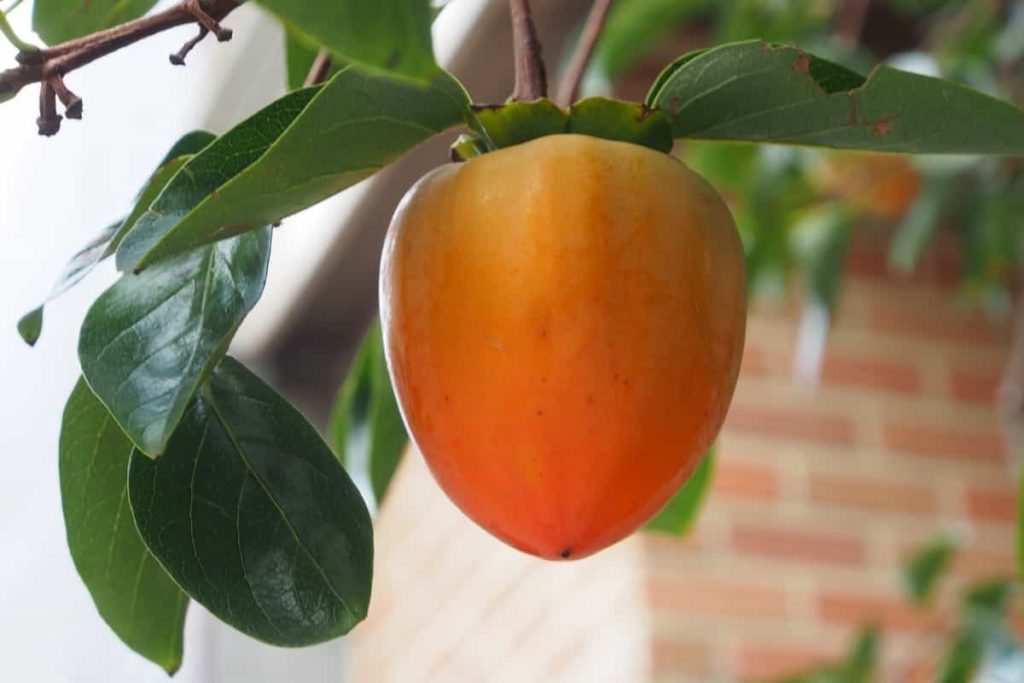
Coffee grounds
Macronutrients like nitrogen, phosphorus, magnesium, and copper are found in coffee grounds. These readily available nutrients are essential for the health of the fruit trees.
Lime
You can add limestone for calcium carbonate every few months throughout the year to help balance acidity levels in the soil.
Compost manure for Persimmon
Compost
Compost can be added from early spring to mid-summer as a mulch. Compost improves overall soil structure and plant growth. It contains moderate amounts of nitrogen, avoiding the problem of over- vegetative growth.
Manure
When planting Persimmon trees in heavy soil, it is good to mix a good planting mixture well with some good organic matter such as composted cow manure, mushroom compost, or soil.
Natural fertilizers for Persimmon
The 3-to-4-inch layer of mulch Spreads over the soil around the Persimmon tree to help maintain moisture and prevent weeds. You can apply mulch a few inches away from the Persimmon tree tunk. Good mulch for the Persimmons is weed-free grass and pine bark.
In case you miss this: Growing Persimmons in Containers from Seed, Seedlings
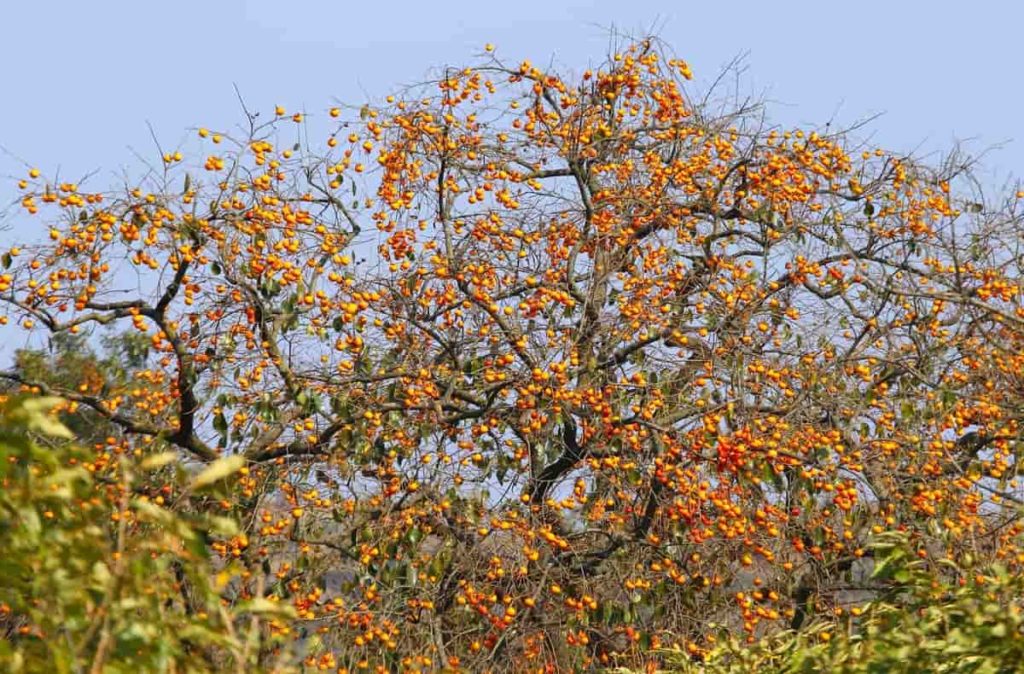
Organic fertilizers for Persimmon
Apply organic fertilizers like fish emulsion, kelp, seaweed extracts, and alfalfa meal fertilizers to the Persimmon trees in early spring. The Kelp meal is an excellent source of micronutrients and beneficial plant growth promoters. Alfalfa meal is a perfect addition to your soil modification schedule. It is an excellent nitrogen source, and it can increase your plant’s photosynthetic capacity and send your production to the next level, both for internal growth and outside.
Liquid fertilizers for Persimmon
Suppose the soil with unhealthy levels of acidity or alkalinity can help in nutrient deficiency, which will harm growth and development. Stay with fertilizer every few months throughout the year, either for weeks, by erecting leaves on water and organic fertilizers like compost tea or fish emulsion, which is found as per the instructions on the package. If your pots don’t have drainage holes, add organic matter like compost tea every few months throughout the year.
Commercial fertilizers for Persimmon
You must choose a fertilizer with balanced nitrogen, phosphorus, and potassium. A fertilizer rich in nitrogen will cause the tree to grow unnaturally fast and drop premature fruit. By adding nitrogen-rich fertilizer to the Persimmon, you lead them to death. Excessive nitrogen accumulation can burn leaves that can lead to tree death. Nitrogen transmits energy to leaves and shoots from fruit production. The fruits fall to the ground prematurely before they are fully ready if the soil contains too much nitrogen.
In case you miss this: Growing Fruits In Shade – A Full Guide
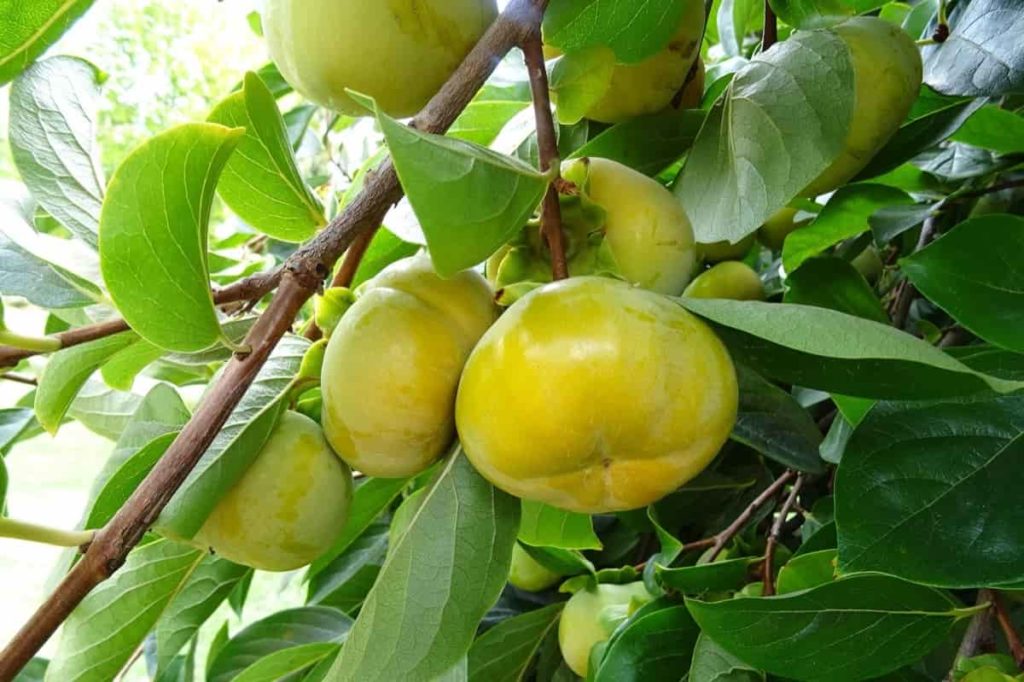
Select chemically balanced fertilizers, such as 10-10-10, containing equal amounts of nitrogen, phosphorus, and soluble potash. Persimmons are not fertilizer-loving plants but need fertilizers for tremendous growth and fruit production. Wear your gloves and spread an even level of fertilizer under the canopy around the tree’s base. Level it by hand. You can also shovel the fertilizer into the soil above to be well found. You must deeply water the soil around the Persimmon tree, so the fertilizer reaches deep to the roots, where it is absorbed.
Persimmon fertilizer schedule
Measure the diameter of the trunk. You can apply 450 grams of 10-10-10 fertilizer per inch of trunk diameter. Using too much nitrogenous fertilizer can cause the Persimmon tree fruit falls prematurely, so choosing a chemically balanced one is essential. Newly planted plants and Persimmon trees less than a year old should receive exceptional care.
Young Persimmon trees should be provided with a balanced fertilizer three times every year during the first few years of life, such as 10-10-10 fertilizer. You should spread the fertilizer evenly around the base of the tree under the canopy so that the soil is enriched over the roots of the Persimmon tree. If an adult tree shows signs of nutritional deficiency, such as yellow or light green leaves, apply fertilizer a second time if they wilt.
How to fertilize Persimmon in pot
If the Persimmons are planted in the loamy soil, they don’t require extra fertilizer. If you don’t have organic-rich soil, you can add some favorable amendments to the ground by planting your Persimmon for a healthy start. Signs that your Persimmon trees may benefit from excess fertilizer, yellow leaves, and stunted growth. Suppose you determine that your Persimmon tree will benefit from fertilizer, plus aged manure and compost. The fertilizer of an organic fruit tree here will be worthwhile buds are being formed, especially around spring.
In case you miss this: Pomegranate Seed Germination, Time, Process (Anar)
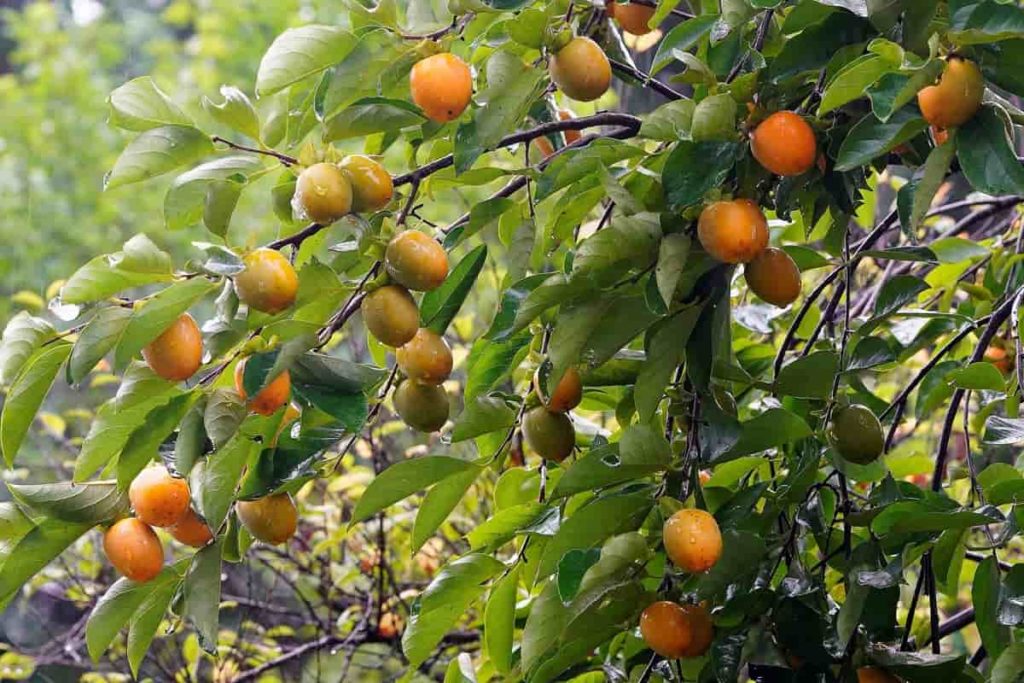
Be careful when applying fertilizers to young Persimmon trees because these trees are susceptible to fertilizers. After a few years, in late winter or early spring, apply balanced fertilizer 10-10-10 if the mature leaves are not dark green and the shoot growth is less than a foot per year. Keep in mind that with the Persimmons, excessive fertilization can cause premature fruit deficiency.
Frequently asked questions about fertilizers for Persimmon (FAQ)
Why are my Persimmon leaves turning yellow?
It is caused by imbalances in potassium, calcium, and magnesium. Yellowness begins with the margin of the leaf and extends towards the veins.
Why is my Persimmon tree dropping leaves?
Usually, it is caused by poor soil drainage rather than excess irrigation. If you plant your Persimmon in the soil area, the water you give to the tree will not pass through the soil. The tree roots will get a lot of moisture and rot, which can cause a drop of Persimmon leaves. Persimmon flowering or fruit fall caused by insufficient sunlight, dehydration, or too much heat.
In case you miss this: Growing a Pomegranate Plant, Propagation, Care
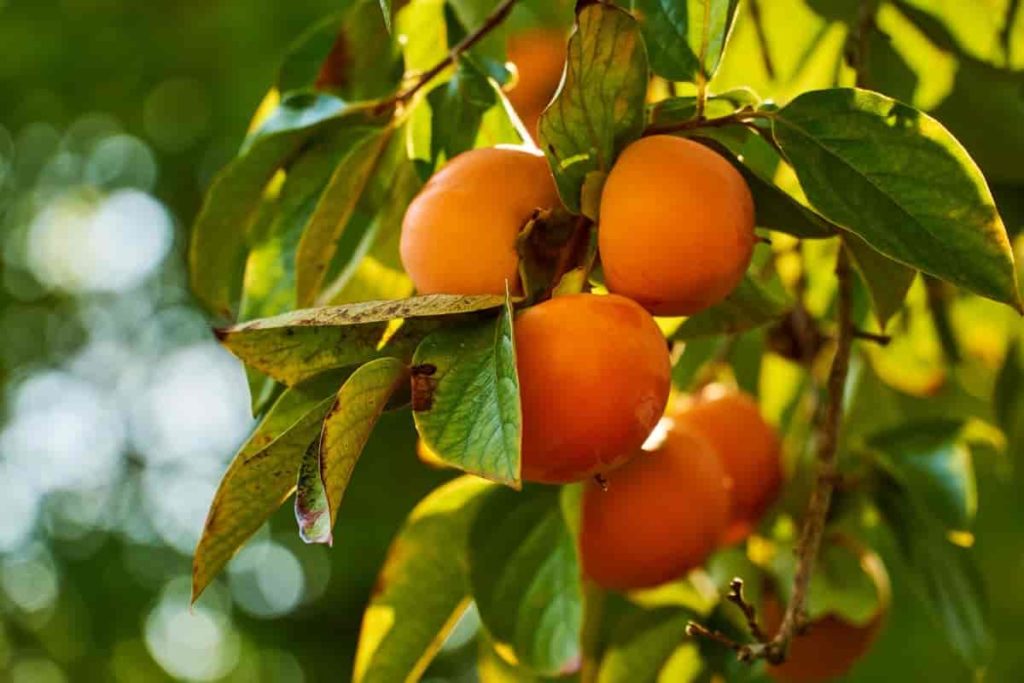
Why are my Persimmon fruits falling?
Fruit drop can be caused by soggy soil (high water or poor drainage), too much shade (less than six hours of non-shade light on summer days), or extreme drought (which will also cause leaves to fall early).
Why is my Persimmon tree not bearing fruit?
Lack of phosphorus may be responsible for non-blooming. This problem is fixed by adding some bone meal to the soil around your tree.
- How to Grow Tomatoes Organically at Home: A Comprehensive Guide
- Organic Gardening on a Budget: Low-Cost Methods and Materials
- Gongura Seed Germination and Planting Methods
- Cabbage Seed Germination and Selection
- Broccoli Seed Germination and Selection
- Asparagus Seed Germination and Variety Selection
- Seasonal Flower Gardening: Best Practices for Spring, Summer, Fall, and Winter
- How to Grow Hibiscus from Flower
- Plantation Ideas for Home Decoration: A Beginners Guide
- Flower Garden Designs and Layouts for Beginners
- Planting and Spacing Techniques in Papaya: A Beginner’s Guide
- Growing Gold: Essential Techniques for Planting Pineapples
- How to Make Kalanchoe Plant Bushy: Home Remedies and Solutions
- 11 Reasons Why Your Gardenia is Not Blooming: Home Remedies and Solutions
- Eco Elegance: The Guide to Designing a Drought-Tolerant Landscape
- Gardening on a Slope: Strategies for Hillside Landscaping
- Nourish and Flourish: Top Organic Mulches for Thriving House Plants
- Everything You Want to Know about Indian Mogra Flower: Discover Uses and Growing
- Green Thumb Success: Expert Tips for Cultivating Greenhouse Pumpkins All Year Round
- Maximize Growth & Flavor: The Ultimate Guide to Companion Planting in Herb Gardens
- How to Control Rhododendron Problems Naturally: Home Remedies and Organic Ways to Fix Them
- Natural Magic: The Remarkable Benefits of Cinnamon for Plants
- Best Steps to Revive Dying Tulip with Natural and Organic Treatment
- 10 Reasons Why Your Angel Trumpet is Not Blooming: Remedies and Treatment
- How to Fix Periwinkle Leaf and Flower-Related Problems: Natural Remedies and Solutions
- How to Fix Zinnias Leaf and Flower Problems: Discover Natural and Home Remedies
- Organic Steps to Induce Lemon Tree Flowers: A Comprehensive Guide
- Bloom Booster: Crafting the Perfect Homemade Bougainvillea Fertilizer
- Optimizing Growth: A Guide to Applying NPK Fertilizer for Potted Plants
- 10 Best Homemade Fertilizers for Rubber Plant: DIY Recipes and Application Method
- How to Boost Female Pumpkin Flowers: Effective Steps for More Flowers and High Yields
- Transform Your Indoor Garden: Top Benefits of Pink Salt for Houseplants
- 10 Best Homemade Fertilizers for Peacock Plants (Calathea): Easy DIY Guide
- Unlock Blooms: 9 Reasons Why Your Potted Chrysanthemum is Not Blooming
- 8 Reasons Why Your Potted Hibiscus is Not Blooming: Fix it with Simple Solutions
- Unlock Blooms: 9 Key Reasons Your Potted Frangipani Won’t Flower